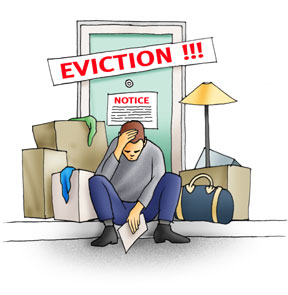 Now, it must be said that there is nothing in the law that compels a landlord to use no-cause evictions. Housing NSW, for instance, makes it a habit to not use them. That's because HNSW knows that, as a Social Housing provider, their tenants are entitled to know the reasons behind having their tenancy agreements ripped up. (It's also because they got dragged through the Supreme Court over the issue in 1991, and lost - in the famous case of Nicholson v NSW Land & Housing Corporation (Unreported, Supreme Court of NSW, 24 December 1991)). There are, of course, several ways to end a tenancy with cause, and generally these days HNSW tries these on instead...
Now, it must be said that there is nothing in the law that compels a landlord to use no-cause evictions. Housing NSW, for instance, makes it a habit to not use them. That's because HNSW knows that, as a Social Housing provider, their tenants are entitled to know the reasons behind having their tenancy agreements ripped up. (It's also because they got dragged through the Supreme Court over the issue in 1991, and lost - in the famous case of Nicholson v NSW Land & Housing Corporation (Unreported, Supreme Court of NSW, 24 December 1991)). There are, of course, several ways to end a tenancy with cause, and generally these days HNSW tries these on instead...But several Community Housing Providers (CHPs) do resort to no-cause evictions. According to our colleagues in the Tenants Advice & Advocacy Services, there are three observable trends in their use:
1. Managing transitional or temporary accommodation - that is, signing an otherwise homeless person up to a 'week-long' fixed-term tenancy in a refuge, and handing over a 90 day termination notice as a sort of appendix to the lease. (This rather interesting practice highlights the need for reform of the marginal rental sector - you can read more about that here).
2. Managing relocations when head-leases evapourate - that is, using a 90 day notice of termination to end the lease on a property that is owned by a private landlord, rented out by a CHP, then sub-let to a social housing tenant, when the private landlord wants the property back. This is, in theory, followed by the CHP finding another place for their sub-tenant to live.
3. Avoiding scrutiny when trying to evict a tenant for a tricky or hard to prove breach - that is, choosing to use no-cause evictions so that tenants can't argue against the reasons behind having their tenancy agreements ripped up, or properly respond to any allegations made against them.
Reliance on no-cause evictions is irksome in any circumstance, but it is particularly so when it comes to Social Housing landlords. They should, by the very nature of their business (not to mention their Regulatory Code), take a more open and transparent approach to ending tenancies.
It is also much more irksome now under the Residential Tenancies Act 2010 than it was under the Residential Tenancies Act 1987, because under that Act tenants did still have some hope of getting through a no-cause eviction without actually being evicted - back then the Tribunal was required to consider the circumstances of the case when deciding on matters of eviction, and had the discretion to call the whole thing off if the CHPs reasons for seeking termination were unsound. (For more information on this change to the law, see the discussion on Swain and the 'circumstances of the case' in this previous post).
But what would a more open and transparent approach to ending tenancies actually look like?
Let's have a look at each of our three scenarios above:
1. Managing transitional or temporary accommodation - for short term and temporary accommodation that is intended to last only as long as it takes to find a person a secure tenancy, occupancy agreements should be used instead of residential tenancy agreements. While there is currently no law requiring (or regulating) the use of occupancy agreements, we hope that this will soon change. In the meantime, CHPs and other socially responsible organisations providing temporary or crisis accommodation are well placed to pioneer the use of occupancy agreements. A sound occupancy agreement would set out the circumstances in which an occupancy can be terminated, and how much notice will be required.
2. Managing relocations when head-leases evapourate - there's simply no need to issue a notice of termination, by either the private landlord to the CHP, or the CHP to the sub-tenant. That's because a tenancy can quite properly be terminated by repudiation and acceptance, or by consent (under section 81(4) of the Act). In either case, the tenancy lawfully ends when vacant possession is returned to the landlord - which happens as a matter of course whenever a tenant moves out of one place and into another. A notice of termination is, in this scenario, nothing but unnecessary double-handling.
3. Avoiding scrutiny when trying to evict a tenant for a tricky or hard to prove breach - for every tricky situation that a Social Housing landlord might encounter, there are probably two notices of termination that could be applied - other than the 90 day notice. These have the added benefit of providing an opportunity for tenants to respond to any allegations made against them. The Tribunal - unless it is sorely mistaken - will not terminate a tenancy with cause unless it is satisfied, on the balance of probabilities, that the alleged cause has been established. In other words, the landlord must prove their case against the tenant before an eviction can occur.
Notwithstanding all of that, there are some compelling reason to regard no-cause evictions by CHPs as unsupported by law. We've run out of time to go into more detail on that side of things this time around... and we'll keep our fingers crossed that the issue will be dead and buried well before Social Housing Month comes around again. Because when it comes to Social Housing, there's really no cause for no-cause evictions.





If a PRIVATE social housing landlord seeks to evict an ELIGIBLE let's call them tenant and then APPLICANT from a VESTED or non vested PUBLIC HOUSING asset then they are now open to PUBLIC laws
ReplyDeleteWhere is the LIABILITY of the PRINCIPALS ie. The MASTER landlord ie. HNSW and the vicarious liability of FACS who allowed eviction of a CLIENT who is now bereft of housing AND support services that were already paid for in the TRUE CONTRACT as was intended.
Dear Anonymous,
DeleteAgreed. Community Housing Landlords should be mindful of the same procedural fairness requirements, when seeking to disrupt a tenants' entitlement to social housing, as their Public Housing counterparts are.
Regards,
N.C.
I think its time you guys start telling supported accommodation providers aka lets limit your rights as a tenant if you dont sign up to our programs to understand you cannot do this if you use the RTA. Especially if you fail to disclose your underlying agreements ie. To collect our personal details and be forced to use our void services under the tenancy act! Seriously.... Give marginal renters a break and dump the one sided ambiguity...
ReplyDelete